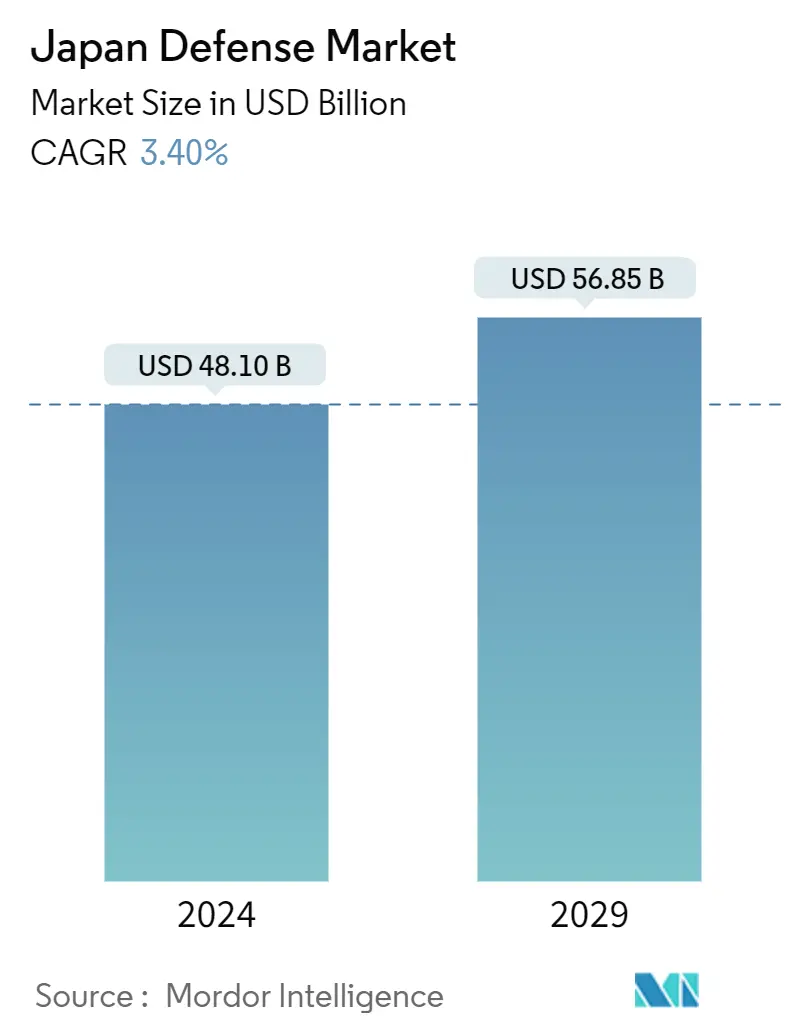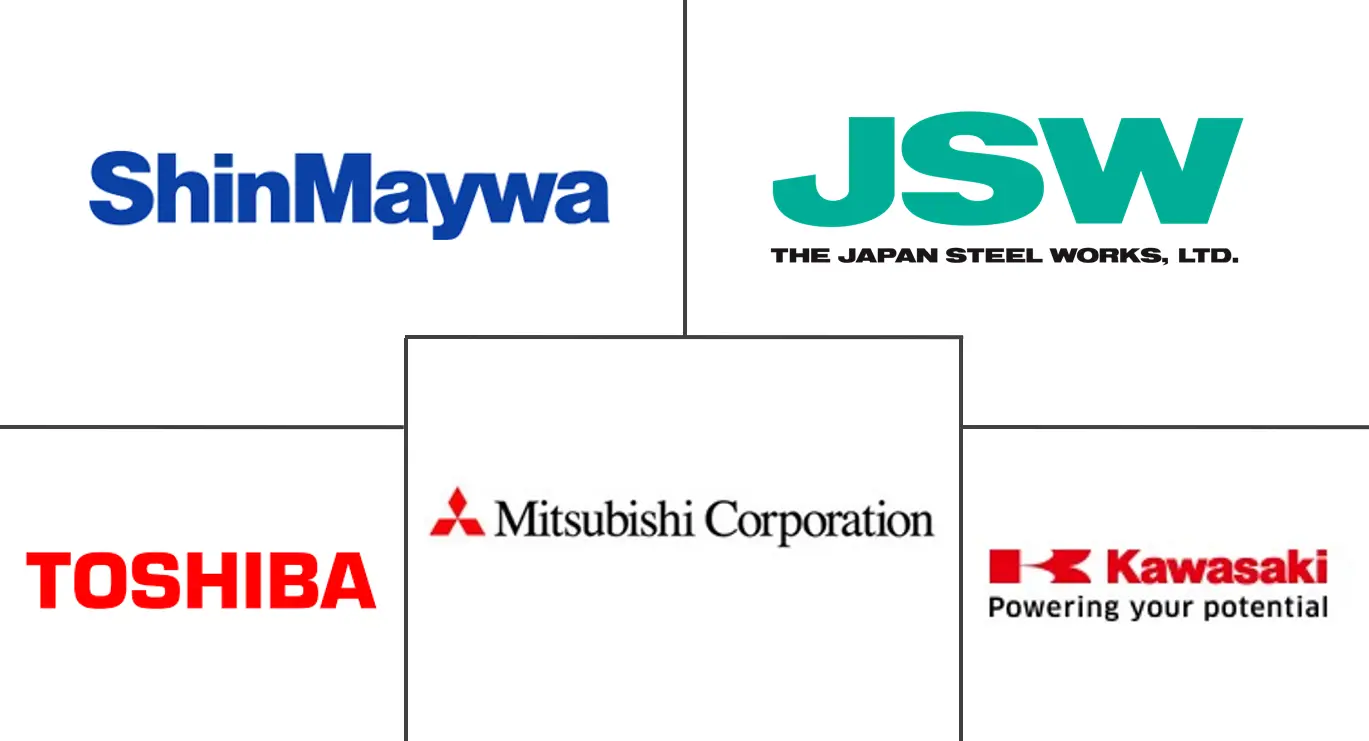Market Size of Japan Defense Industry

| Study Period | 2019-2029 |
| Base Year For Estimation | 2023 |
| Market Size (2024) | USD 48.10 Billion |
| Market Size (2029) | USD 56.85 Billion |
| CAGR (2024 - 2029) | 3.40 % |
| Market Concentration | Medium |
Major Players
*Disclaimer: Major Players sorted in no particular order |
Japan Defense Market Analysis
The Japan Defense Market size is estimated at USD 48.10 billion in 2024, and is expected to reach USD 56.85 billion by 2029, growing at a CAGR of 3.40% during the forecast period (2024-2029).
- The security environment in Japan has become increasingly stressed, with several international challenges and destabilizing factors becoming more acute. Hence, to adapt to the growing changes in the security environment, Japan has been strengthening its defense capabilities at a rapid pace. According to the report published by the Stockholm International Peace Research Institute (SIPRI) in 2022, Japan was the tenth largest defense spender in the world, with a defense budget of USD 46 billion. The country approved USD 51.4 billion in defense spending in FY2023.
- Japan is modernizing its defense arsenal, which involves upgrades in air and maritime defense systems as well as investments in space and cyber capabilities. In order to realize cross-domain operations, the armed forces are planning to acquire and strengthen capabilities in new domains, including space, cyberspace, and the electromagnetic spectrum, by investing financial resources into the R&D of such systems, which is expected to drive market growth.
- The Japanese defense market faces several challenges that may act as restraints in the forecast decade. Geopolitical tensions in the Asia-Pacific region may pose some challenges, as Japan has delicate relationships with neighboring countries. Secondly, Japan's strict arms export policies may limit its defense industry's global sales. These policies could block the growth of the defense market by restricting international collaborations and sales.
- The Japanese defense market presents opportunities due to the evolving security landscape, marked by regional tensions, which creates a demand for advanced defense technologies. Manufacturers in Japan can capitalize on this by investing in research and development and promoting innovation in areas such as cybersecurity, unmanned systems, and artificial intelligence. Similarly, collaborations with international partners can open opportunities for technological advancements and joint ventures. Manufacturers can leverage global expertise by forming strategic alliances. Additionally, Japan’s initiatives to ease some restrictions on arms exports may unlock new markets for Japanese defense manufacturing companies.
Japan Defense Industry Segmentation
The study covers all aspects and provides insights into the budget allocation and spending in the Japanese defense market, along with the forecast estimates. The market includes details about the procurement and modernization plans of the Japan Self-Defense Forces including aircraft, land tactical vehicles, naval vessels, unmanned systems, and military equipment like weapon systems, missile defense systems, missiles, ammunition, etc. The market also includes details regarding investments in the research and development of advanced technologies like directed energy weapons, the use of composites, and advanced manufacturing technologies like 3D printing, among others.
The Japanese defense market is segmented by armed forces and type. By armed forces, the market is segmented into the Airforce, army, and navy. By type, the market is segmented into personal training and protection, C4ISR and EW, vehicles, and weapons and ammunition.
The market sizing and forecasts have been provided in value (USD).
| Armed Forces | |
| Air Force | |
| Army | |
| Navy |
| Type | |
| Personnel Training and Protection | |
| C4ISR and EW | |
| Vehicles | |
| Weapons and Ammunition |
Japan Defense Market Size Summary
The Japan defense market is poised for significant growth over the forecast period, driven by the country's response to an increasingly complex security environment. Japan's defense strategy is focused on modernizing its military capabilities, with substantial investments in air, maritime, space, and cyber defense systems. The country is actively enhancing its air force capabilities, including the acquisition of advanced fighter jets and the development of domestically produced stealth aircraft. Additionally, Japan is expanding its defense infrastructure to include new domains such as cyberspace and electronic warfare, reflecting a comprehensive approach to national security. The market is characterized by a semi-consolidated structure, with key players like Kawasaki Heavy Industries and Mitsubishi Heavy Industries leading the charge in innovation and development.
Despite the challenges posed by geopolitical tensions and strict arms export policies, the Japanese defense market presents numerous opportunities for growth. The relaxation of arms export restrictions and increased collaboration with international partners are expected to open new markets and enhance technological capabilities. The market's expansion is further supported by rising investments in research and development, particularly in advanced technologies like cybersecurity and unmanned systems. Japan's defense spending is on the rise, with significant allocations for procurement and development projects, including long-range missiles and next-generation fighter aircraft. These developments underscore Japan's commitment to strengthening its defense posture and maintaining a competitive edge in the global defense industry.
Japan Defense Market Size - Table of Contents
-
1. MARKET DYNAMICS
-
1.1 Market Overview
-
1.2 Market Drivers
-
1.3 Market Restraints
-
-
2. MARKET SEGMENTATION
-
2.1 Armed Forces
-
2.1.1 Air Force
-
2.1.2 Army
-
2.1.3 Navy
-
-
2.2 Type
-
2.2.1 Personnel Training and Protection
-
2.2.2 C4ISR and EW
-
2.2.3 Vehicles
-
2.2.4 Weapons and Ammunition
-
-
Japan Defense Market Size FAQs
How big is the Japan Defense Market?
The Japan Defense Market size is expected to reach USD 48.10 billion in 2024 and grow at a CAGR of 3.40% to reach USD 56.85 billion by 2029.
What is the current Japan Defense Market size?
In 2024, the Japan Defense Market size is expected to reach USD 48.10 billion.

